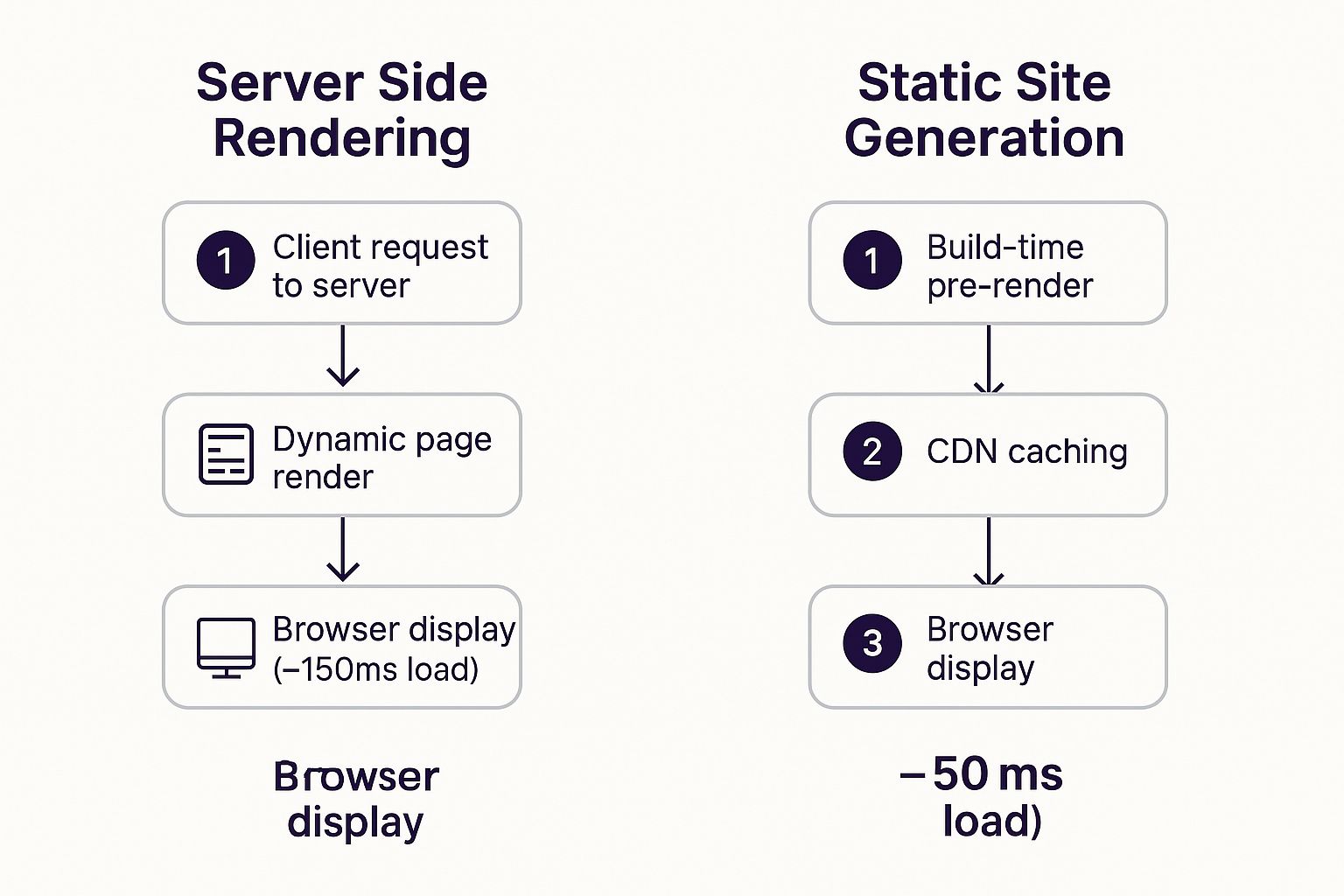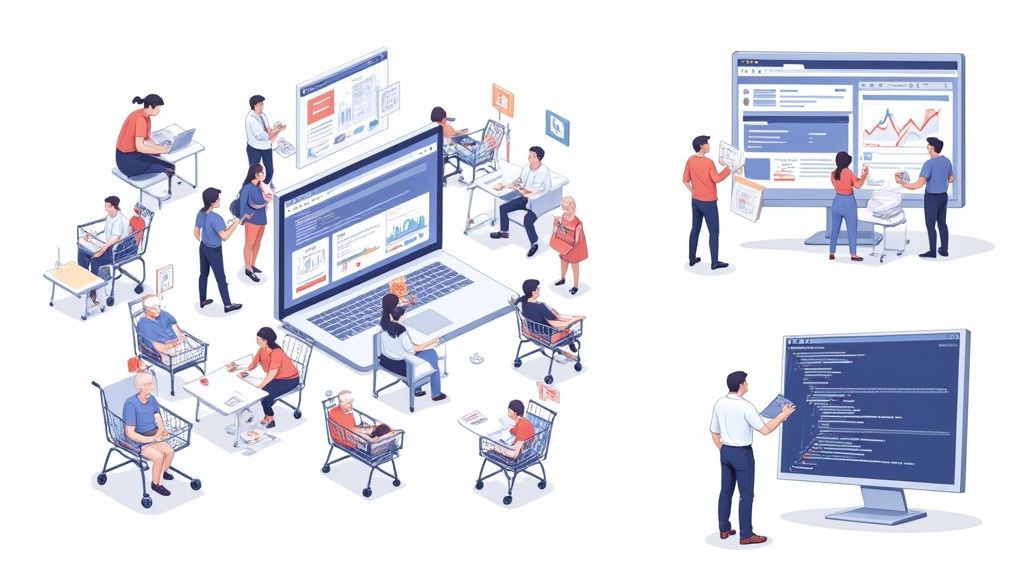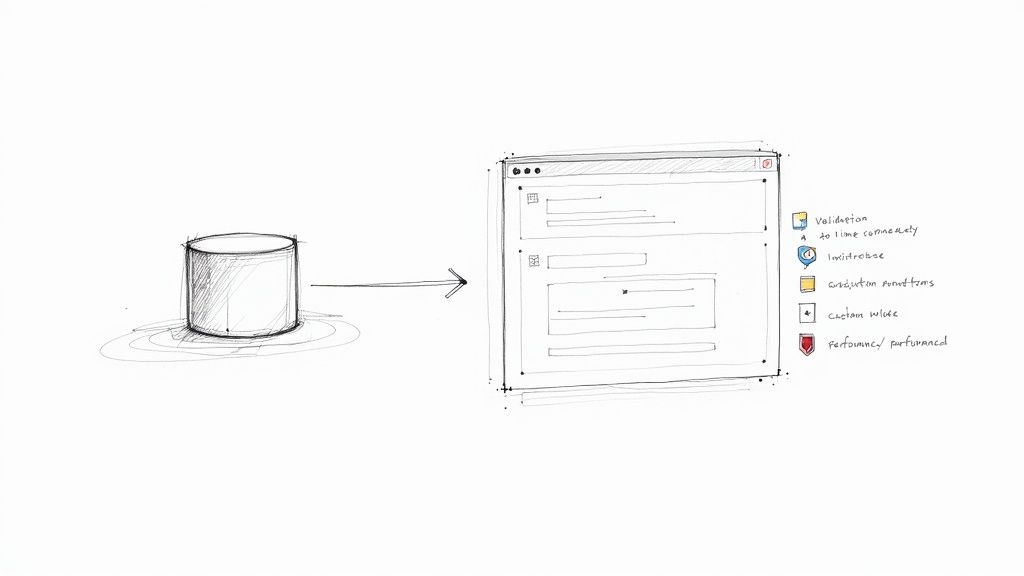
Is your website secretly a boat anchor? It looks fine on the surface, but under the water, it's heavy, slow, and holding your business back. I've seen it countless times: a potential customer lands on a site, waits five… six… seven seconds for it to load, and just clicks away. That's a lost sale. A direct hit to your revenue. This isn't just a tech headache; it's a business problem that quietly strangles your growth.
This is exactly where the conversation about Next.js development services gets interesting. We're not just talking about hiring coders to build another website. It's about bringing in a specialized team to solve the kind of deep seated business pains that many companies don't even realize are coming from their website's architecture. It's about turning that boat anchor into a rocket ship.
Why Smart Businesses Invest in Next.js Development
Let's be real—going from a sluggish, frustrating website to a high performance digital asset can feel like a massive leap. Many businesses are stuck dealing with issues that seem unrelated but are actually all connected:
- Painfully Slow Site Speed: Every extra second a user has to wait is another conversion you've lost.
- Dismal SEO Rankings: If Google's crawlers can't make sense of your site quickly and efficiently, you might as well be invisible.
- Clunky User Experiences: Confusing navigation and slow, laggy interactions are a surefire way to send visitors packing.
These aren't just minor annoyances. They're symptoms of a weak foundation that a generic, off the shelf solution can't fix. This is where Next.js shines. It was literally built to tackle these very challenges head on. A huge reason savvy businesses invest in Next.js is its built in support for solid technical SEO best practices, which gives you a real shot at climbing the search rankings.

From Frustration to Performance
To put it in perspective, let's look at some common business challenges and see how Next.js provides a direct solution.
| Common Business Problem | How Next.js Solves It |
|---|---|
| High bounce rates from slow page loads | Next.js uses server side rendering (SSR) and static site generation (SSG) to serve pre rendered pages instantly, drastically cutting down wait times. |
| Poor visibility in search engine results | Its architecture is inherently SEO friendly, making it easy for Google to crawl and index your content, which is crucial for ranking higher. |
| Inability to scale during traffic spikes | The framework is built on React and supports serverless functions, allowing your application to handle sudden increases in traffic without crashing. |
| Fragmented and inconsistent user experience | Next.js's component based structure ensures a consistent and predictable UI across your entire application, making it more intuitive for users. |
These are the kinds of tangible problems that a skilled Next.js team can help you solve, turning your website from a liability into a growth engine.
A Strategic Partnership for Growth
The demand for better, faster digital experiences is driving massive growth in the web development world. The global market is expected to hit $74.69 billion in 2025 and is projected to climb to $104.31 billion by 2030. This isn't just hype; it reflects a fundamental shift toward web applications that are faster, more secure, and highly personalized—all areas where Next.js has a clear advantage.
Bringing on a Next.js development service is less like buying a product and more like forming a strategic partnership. It's a collaboration to translate your business goals into a high performance application that doesn't just attract customers, but actually keeps them coming back.
When you get down to it, investing in Next.js means you're choosing a foundation that's built for long term growth, scalability, and an unbeatable user experience. It's the difference between just having a website and owning a powerful business asset.
Understanding the Core Powers of Next.js
So, what actually makes Next.js the powerhouse everyone's talking about? It's not just about writing code; it's about how that code gets delivered to your user's browser. I once spent an entire afternoon pulling my hair out over a performance issue on a client's site, only to realize the problem wasn't the code itself, but how the page was being built and sent over the wire.
This is where Next.js fundamentally changes the game. It hands developers two incredible superpowers for building websites: Server Side Rendering (SSR) and Static Site Generation (SSG).
Before we go deeper, let's use an analogy. Think of them as two different styles of a gourmet meal service.
The Personal Chef vs. The Meal Prep Service
Server Side Rendering (SSR) is like hiring a personal chef. When a user requests a page, the server (our chef) gets to work immediately. It gathers all the necessary, fresh ingredients—data from your database, user information—and cooks up a fully prepared HTML page right on the spot.
This made to order approach means the content is always dynamic and up to the minute. It's perfect for personalized user dashboards or e commerce sites where product availability changes constantly. The user gets a complete meal delivered hot and ready.
On the other hand, Static Site Generation (SSG) is like a gourmet meal prep service. All the meals (your website's pages) are cooked, perfectly portioned, and packaged before anyone even thinks about ordering. They're then stored in refrigerators all over the world (a Content Delivery Network, or CDN).
When a user wants a page, it's instantly served from the nearest location. Bam. This method is unbelievably fast and efficient, making it ideal for blogs, marketing sites, or documentation pages where the content doesn't change with every single visit.
This infographic breaks down the difference between these two rendering strategies, showing how each path delivers the final page to the user.

The key takeaway is simple: SSG offers a massive speed advantage by preparing content ahead of time, while SSR provides the flexibility to generate dynamic content on demand.
Why This Matters for Your Business
This isn't just technical jargon; these rendering methods have a huge impact on your business goals. A faster website isn't a vanity metric—it directly influences user behavior and your bottom line.
- Blazing Fast Page Loads: Studies consistently show that even a one second delay in page load time can lead to a 7% reduction in conversions. By serving pages that are either pre built (SSG) or quickly assembled on the server (SSR), Next.js slashes that initial wait time.
- Superior SEO Performance: Google loves fast websites. Because Next.js sends fully formed HTML to the browser from the get go, search engine crawlers can easily read and index your content. This gives you a serious advantage over traditional client side rendered apps that send a blank page first.
- Unbeatable User Experience: A snappy, responsive site just feels more professional and trustworthy. When users can navigate without frustrating delays, they're far more likely to stick around, engage with your content, and ultimately convert.
The real magic of Next.js is that you don't have to pick just one. You can use a hybrid approach, applying the best rendering strategy for each specific page. Your marketing blog can be static and instant, while your user dashboard is dynamic and personalized.
This flexibility is a complete game changer. It allows a skilled Next.js development services provider to build a highly optimized application tailored to your exact needs, including building out robust API layers to handle data. For a deeper dive, you might find our guide on API documentation best practices useful, as it's a critical piece of building scalable systems.
Ultimately, this thoughtful architecture translates directly into a better product for your customers and better results for your business.
Your Project Journey with a Next.js Team
Stepping into a partnership with a development team can feel like a leap of faith. I get it. There are a million questions buzzing around your head: "Will they really get my vision?" or "How do we keep this project from spiraling out of control with scope creep?" These are perfectly normal anxieties.
The truth is, a great engagement is a collaborative journey, not just a transaction. It's a structured process designed to build trust and turn your abstract idea into a tangible, high performance application. Let's walk through that journey together, step by step, so you know exactly what to expect.

Phase 1 Discovery and Strategy
This is where it all begins. Think of this as the architectural blueprinting phase. Before a single line of code is written, we need to get on the same page about what we're building, why we're building it, and who we're building it for. This isn't just a casual chat; it's a deep dive.
Your role here is to be the expert on your business. You bring the vision, the domain knowledge, and the customer pain points. Our role is to listen intently, ask probing questions, and start translating your business needs into a technical strategy.
- Key Activities: We'll conduct stakeholder interviews, analyze your target audience, and map out user journeys. We define the core features for a Minimum Viable Product (MVP) and establish clear success metrics.
- Your Deliverable: A comprehensive project roadmap and a detailed scope document. This document acts as our shared source of truth, preventing misunderstandings down the line.
This initial phase is also where we tackle the big questions around timelines and budget. Creating a realistic estimate is both an art and a science, something we've spent years refining. If you're curious about what goes into it, check out our guide on how to get a realistic software project estimate.
Phase 2 UI/UX Design
With a solid strategy in place, we move on to crafting the user experience. This is where your application starts to get a personality. We're not just making things look pretty; we're designing an intuitive and seamless experience that guides users toward their goals.
We start with low fidelity wireframes—simple black and white sketches—to focus purely on layout and flow. Once we agree on the structure, our designers bring it to life with high fidelity mockups that reflect your brand's colors, typography, and visual identity. You'll get to see exactly what the final product will look like.
Phase 3 Development Sprints
Now, the real magic happens. We break down the project into manageable two week cycles called sprints. This agile approach allows for incredible flexibility and transparency. Instead of disappearing for months and coming back with a finished product, we deliver working software in small, incremental pieces.
At the end of each sprint, we hold a demo where you can see and interact with the new features we've built. This creates a powerful feedback loop.
- Your Role: Participate in sprint planning to help prioritize features and provide feedback during the end of sprint demos.
- Our Role: Write clean, production grade code, conduct rigorous testing, and manage the development workflow to ensure we stay on track.
This iterative process is key to providing top tier Next.js development services. It ensures the final product is not just what was planned, but what is actually needed.
Phase 4 Launch and Ongoing Support
The launch isn't the end; it's the beginning of a new chapter. We handle the entire deployment process, ensuring your application goes live smoothly.
But our partnership doesn't stop there. The digital world is always moving, and we're here to provide ongoing support, monitor performance, and plan for future enhancements. This is how we ensure your investment continues to deliver value long after the initial launch.
How to Choose Your Ideal Next.js Partner
Picking a partner for your Next.js development services is a lot like choosing a cofounder. Seriously. It's a huge decision that goes way beyond a slick portfolio or a low price tag.
I once worked with a client who picked an agency based on price alone. Six months later, they were stuck with a beautiful but completely unmaintainable mess of code. It was a costly lesson in looking past the surface.
Finding the right team is about finding a true collaborator, a group that will act as a genuine extension of your own. You need to ask the kind of questions that reveal their real process, their philosophy, and—most importantly—their communication style.
Beyond the Portfolio: The Questions That Matter
A portfolio shows you what a team can build, but it doesn't tell you how they build it or what it's like to work with them day to day. To get that kind of insight, you have to dig a bit deeper.
Here are some questions that will help you separate a great partner from a merely good one:
- "How do you approach managing technical debt?" Their answer reveals their commitment to long term quality. A good team will have a clear strategy for identifying, prioritizing, and paying down tech debt to keep the codebase healthy.
- "Can you walk me through your communication protocol for unexpected issues?" Problems are inevitable. What really matters is how they're handled. You're looking for transparency, a clear point of contact, and a process for quick escalation.
- "What does your code review process look like?" This is a massive indicator of quality control. A strong answer will involve multiple reviewers, automated checks, and a focus on constructive, actionable feedback.
- "How do you balance shipping features quickly with maintaining code quality?" This question gets to the heart of their pragmatism. The ideal partner understands it's a trade off and can articulate how they make those decisions collaboratively with you.
Understanding Engagement Models
Not all projects are the same, so the way you engage with a development team shouldn't be a one size fits all deal. Understanding the different models helps you pick the right fit for your budget, timeline, and how involved you want to be.
- Fixed Price: Best for projects with a crystal clear, unchangeable scope. You agree on a set price for specific deliverables. It offers budget predictability but can be rigid if you need to make changes down the road.
- Time & Materials: You pay an hourly or daily rate for the work done. This model offers maximum flexibility, making it perfect for complex projects where the scope is likely to evolve as you go.
- Dedicated Team: You essentially hire a full time team that works exclusively on your project. This is the most collaborative model, ideal for long term, large scale product development where you need deep integration with your own people.
The growing demand for JavaScript expertise reflects this need for specialized partnerships. The global market for JavaScript development services, which includes frameworks like Next.js, is projected to hit $15 billion in 2025 and is expected to grow by around 10% annually through 2033. This growth is driven by businesses needing sophisticated, full stack solutions that only expert teams can provide. Discover more insights about this growing market on datainsightsmarket.com.
Red Flags and Green Flags: A Practical Checklist
As you interview potential partners, keep an eye out for signals—both good and bad—that can tell you a lot about what it will actually be like to work with them. A partnership built on transparency and shared goals will always outperform one built on a rigid contract.
Look for a team that is as invested in your business success as you are. They should feel like they're on your side of the table, not across from it.
To help you vet potential teams, I've put together a checklist based on years of experience seeing these partnerships succeed and fail.
Choosing Your Development Partner Checklist
| Evaluation Criteria | Key Questions to Ask | Red Flags to Watch For |
|---|---|---|
| Technical Expertise | Can you show me a complex Next.js project you've built? What were the biggest technical challenges? | They only show simple marketing sites. Their answers to technical questions are vague or full of buzzwords. |
| Communication & Process | What tools do you use for project management and communication? How often will we have check ins? | They don't have a clear process. Communication seems infrequent or disorganized. You can't get a straight answer on who your main contact will be. |
| Cultural Fit | How do you handle disagreements or scope changes? | They agree to everything you say without pushing back or asking clarifying questions. This often means they aren't thinking critically about your project. |
| Transparency | Can I speak directly with one of the developers who would be on my project? | They are reluctant to let you talk to their technical team. Everything is funneled through a salesperson. |
| Long Term Vision | How do you ensure the code you write today will be maintainable in two years? | They focus solely on the initial build and don't have good answers about documentation, testing, or handoff procedures. |
At the end of the day, finding the right partner is just as critical as the technology you choose. Taking the time to vet thoroughly ensures you find a team that won't just build your software, but will help you build your business.
For a broader perspective on making these foundational choices, you can learn more about how to choose a technology stack in our detailed guide.
Real World Examples of Next.js in Action
It's one thing to talk about rendering strategies and another to see them deliver results in the real world. Theory is great, but the moment Next.js really clicks is when you see it powering applications you probably use every day. Let's move from the abstract to the concrete and look at how Next.js development services are solving high stakes problems for some of the biggest names out there.
These aren't just simple marketing sites; they're complex platforms where performance is directly tied to the bottom line.

High Traffic Ecommerce Platforms
Picture a massive online retailer like Walmart. They're dealing with millions of daily visitors, and every single person expects a fast, smooth shopping experience. For them, a one second delay isn't a minor hiccup—it's potentially millions in lost sales.
This is exactly the kind of high pressure environment where Next.js shines.
- The Challenge: They need to serve millions of dynamic product pages. Inventory and pricing are constantly changing, but load times have to stay lightning fast to keep conversion rates high.
- The Next.js Solution: This is where a hybrid rendering approach becomes a game changer. Product listing pages can be statically generated at build time (SSG) for instant loading. Individual product pages, on the other hand, can use Incremental Static Regeneration (ISR). This means a popular product page is cached and served instantly, but it automatically re fetches the latest price and stock levels in the background every few minutes.
- The Business Impact: This smart strategy gave them a huge performance boost. Reports showed a 20% increase in conversion rates directly linked to faster page loads. For a company of that size, that's a massive win.
Content Rich Media and Marketing Sites
Now, let's switch gears and think about a company like Twitch or Hulu. Their entire business is content, and their main goal is to get that content in front of as many people as possible. For them, Search Engine Optimization is everything. Their pages have to be not only fast but also perfectly built for Google's crawlers.
For content driven businesses, SEO isn't just a feature; it's the entire distribution channel. If your pages aren't indexed properly, you effectively don't exist.
- The Challenge: How do you manage and serve a huge library of content—videos, articles, show descriptions—in a way that's incredibly fast for users and highly discoverable for search engines?
- The Next.js Solution: Server Side Rendering (SSR) is the hero here. When a search engine crawler hits a page, Next.js renders the full HTML on the server and sends back a complete, content rich document. This is exactly what search engines love to see, leading to better indexing and higher rankings.
- The Business Impact: By making sure every piece of content is perfectly optimized for search, these platforms have seen their organic traffic explode. A well built Next.js site can drive a 40% or more increase in organic traffic within just a few months.
The widespread adoption of Next.js isn't just a fad; it's a strategic business decision. By 2025, it's been verified that over 17,921 companies worldwide are using Next.js for their web applications. This is a testament to its ability to deliver killer performance and SEO advantages across all kinds of industries, from business services to massive retail operations. You can discover more insights about Next.js adoption on data.landbase.com.
So, What's Next on Your Journey to a Better Web Experience?
We've covered a lot of ground, from the everyday business headaches that slow sites cause to the nitty gritty of how Next.js works. My hope is that you now see it as more than just another piece of tech—it's a real strategic tool that can drive growth.
Making the right move from here isn't about just hiring a vendor. It's about finding a genuine partner, someone who digs deep to understand your goals and can turn them into a web application that actually performs.
A solid, transparent process and true collaboration are the absolute bedrock of any project that's built to last. It's all about building trust, having open conversations, and treating your digital presence with the care it deserves. Every single step, from that first discovery call to the final launch, should feel like a true partnership.
Key Takeaways to Keep in Mind
Before you jump into your next big project, let's quickly recap the most important points we've discussed:
- Next.js is a Business Tool: Its features directly tackle critical issues like sluggish site speed, poor SEO, and a clunky user experience—all things that directly hit your bottom line.
- The Right Partner is a Collaborator: Look past the shiny portfolio. Ask the tough questions about their process, how they communicate, and the long term maintainability of their code. You're looking for a team that feels like an extension of your own.
- A Transparent Process is Non Negotiable: The path from an idea to a live application should be a clear, step by step journey with constant feedback loops. No surprises, no black boxes.
Choosing to invest in expert Next.js development services is a commitment to quality and a bet on your own future growth. It's a decision to build something that lasts, something that performs, and something that your customers will love using.
After you've invested in a high performance website, making sure people can actually find it is the critical next step. For that, a comprehensive guide to search engine indexing can be an invaluable next read to ensure your new site gets the visibility it deserves.
Feeling inspired, or maybe you still have a few questions rattling around? That's great. The best projects always start with a simple conversation. Feel free to explore our other articles, or if you're ready to talk specifics, go ahead and schedule a no pressure consultation to discuss your goals.
About the Author
Kuldeep Pisda is a full stack engineering consultant who helps early stage startups build robust, scalable systems with Django, Next.js, and AI. He focuses on thoughtful architecture and pragmatic delivery to accelerate product roadmaps and establish strong technical foundations.
Frequently Asked Questions About Next.js Services
Whenever you're looking at bringing in new tech or a new partner, a few questions always bubble to the surface. It's smart to press pause and think about the practical stuff—cost, fit, and what you're really getting out of it. Let's dig into the common questions I hear from businesses thinking about Next.js development services.
How Much Do Next.js Development Services Cost?
This is usually the first question out of the gate, and the only honest answer is: it depends. I know that's not the single number you might be hoping for, but throwing one out would just be a wild guess. The cost is a direct reflection of what you're trying to build, not a one size fits all price tag.
Several key factors will shape the final investment:
- Project Scope: Is this a slick, five page marketing site or a sprawling e commerce platform with all the bells and whistles? The sheer size and feature list is the biggest driver of cost.
- Complexity: A project that needs to talk to multiple third party APIs, has custom login logic, or juggles real time data is going to need more development muscle than a straightforward informational site.
- Team Structure: The size and experience of the team also come into play. A senior led team might have a higher rate, but they often solve problems faster and build a more solid product in the long run.
Think of it less like buying something off the shelf and more like commissioning a custom piece of architecture. The cost is built from the blueprint.
Is Next.js a Good Choice for a Small Business Website?
Absolutely. I've seen small businesses get hesitant, thinking Next.js might be overkill. That's a short term view. The real magic of Next.js for a small business is its scalability—it's a future proof investment.
You can start small with a simple, blazing fast static site that gets your message out there. But what happens next year when you want to add a blog? Or an online store? Or a customer portal? With Next.js, you don't have to tear everything down and start over. Its architecture is designed to let you seamlessly layer on dynamic, complex features as your business grows.
Choosing Next.js from the start means you're building on a platform that can grow with you, not one you'll outgrow in a year. It's about setting yourself up for success from day one.
How Does Next.js Improve SEO Over a Standard React App?
This is where Next.js delivers a massive, tangible win. Picture a search engine crawler as a very busy inspector on a tight schedule. Their job is to look at your site and figure out what it's all about, fast.
A standard client side React app hands that inspector a mostly empty HTML file. The real content only pops in after a bunch of JavaScript runs in the browser. The inspector is busy; they might not wait around for all that to happen and could just move on without getting the full picture.
Next.js, with its server side rendering (SSR), is like having a helpful assistant. It builds the complete, content rich HTML page on the server before sending it over. When the inspector shows up, they get a full, easy to read document instantly. This makes their job a breeze, leading to better indexing and a real, measurable boost in your search rankings.
Ready to turn your vision into a high performance web application? At Kuldeep Pisda, I partner with startups and businesses to build robust, scalable systems that drive growth. Let's start a conversation about your project. Explore my consulting services.
Become a subscriber receive the latest updates in your inbox.





Member discussion